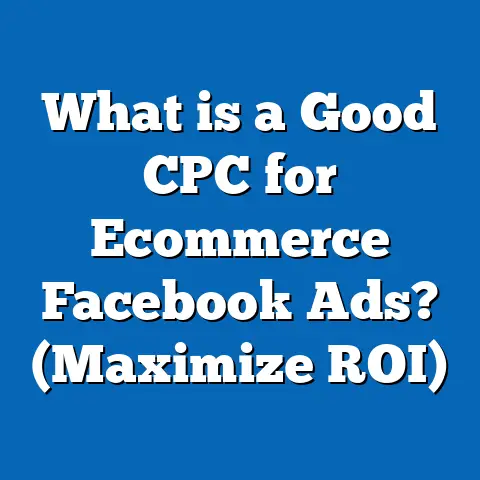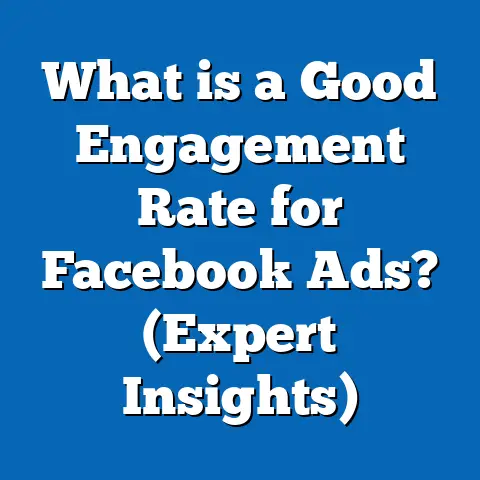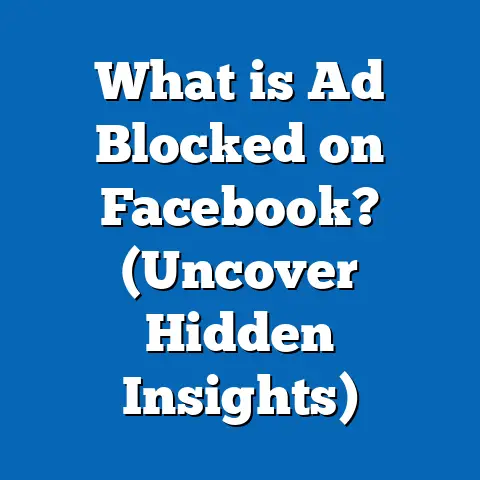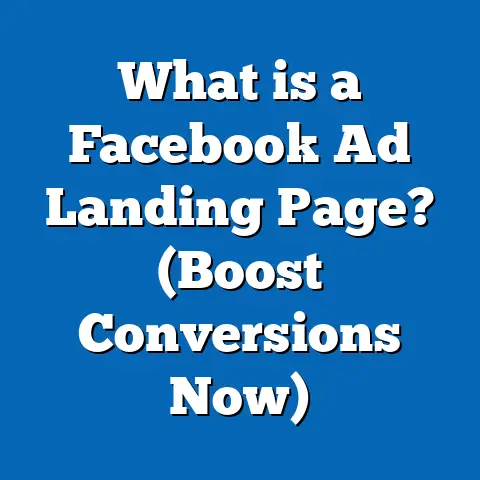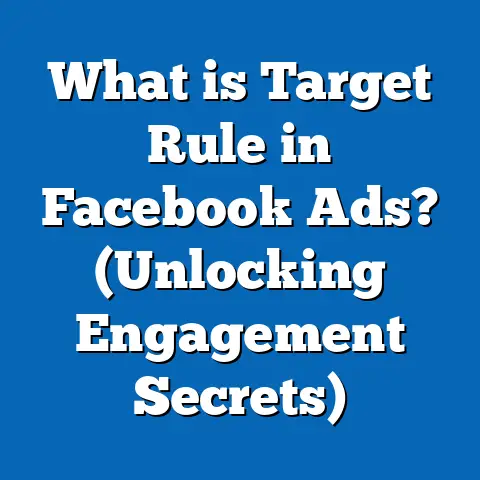What is a Messenger Ad on Facebook? (Unlocking Engagement Tactics)
Imagine having a conversation with your potential customers right where they spend hours every day — their messaging app. Messenger ads are designed to do exactly this. They unlock new engagement opportunities by combining targeted advertising with real-time interaction. This guide will walk you through everything you need to know about Messenger ads, from basic concepts to advanced engagement tactics that can transform your marketing game.
Understanding Messenger Ads: The Basics
What Are Facebook Messenger Ads?
Messenger ads are a type of paid advertisement that appears within the Facebook Messenger app. Unlike traditional static or video ads that display in users’ news feeds, Messenger ads allow businesses to initiate or continue conversations directly within the messaging environment.
This direct communication channel has redefined how brands interact with customers by making the experience personal, immediate, and two-way.
Types of Messenger Ads
There are primarily two types of Facebook Messenger ads:
1. Inbox Ads
These ads appear within the Messenger app’s home screen, where all user conversations are listed. They look similar to regular messages but are marked as sponsored. When users tap on these ads, it opens a conversation thread with the business.
- Example: A travel company sends an Inbox ad promoting a last-minute flight deal. When users click it, they open a chat offering personalized itinerary options.
2. Sponsored Messages
Sponsored messages are sent directly into the inbox of users who have previously interacted with your business via Messenger. These messages allow you to re-engage warm leads or customers with targeted offers or updates.
- Example: An e-commerce store sends a sponsored message offering a discount code to users who abandoned their shopping cart.
Why Use Messenger Ads?
Messenger ads offer several advantages over traditional Facebook ads:
- Higher Engagement: Messaging feels natural and personal, driving better user interaction.
- Two-Way Communication: Unlike static ads, Messenger ads allow users to respond immediately.
- Efficient Lead Qualification: Bots or salespeople can quickly qualify leads through automated or live conversations.
- Cost Efficiency: Higher conversion rates can lead to lower cost per acquisition (CPA).
- Integration: Seamlessly connects with Facebook’s powerful targeting tools and analytics.
Data-Backed Insights: Why Messenger Ads Work
The Power of Messaging in Marketing
Messaging apps have overtaken social networks in active users worldwide. As of 2024:
- Over 1.3 billion people use Facebook Messenger monthly (Statista).
- Messaging apps like WhatsApp and Messenger combined have over 3 billion active users globally.
- 70% of consumers prefer messaging businesses over calling for support (Twilio Consumer Report).
Engagement Metrics Compared
Facebook’s internal data shows:
| Metric | Facebook Feed Ads | Messenger Inbox Ads | Sponsored Messages |
|---|---|---|---|
| Average Click-Through Rate | 0.9% | 1.2% – 1.5% | 2 – 3% |
| Conversion Rate | 2% | 3 – 4% | 5 – 6% |
| Average Cost Per Click (CPC) | $0.75 | $0.55 – $0.65 | $0.40 – $0.50 |
Messenger ads outperform traditional placements in both engagement and cost-efficiency.
Case Study: HubSpot Report on Personalized Messaging
HubSpot’s marketing research shows that personalized messaging through chat apps increases conversion rates by up to 50% compared to generic email or social media ads.
User Preference and Behavior
According to Facebook Business Insights:
- 53% of people are more likely to shop with businesses they can message directly.
- 61% find it easier to get quick answers via messaging apps.
- Brands that actively use Messenger for customer support report a 25% increase in customer satisfaction scores.
How Messenger Ads Work: A Step-by-Step Breakdown
Step 1: Define Your Campaign Objective
Facebook Ads Manager offers various objectives tailored for Messenger ads:
- Traffic: Drive users to open a chat.
- Lead Generation: Collect user information via conversation.
- Conversions: Encourage purchases or sign-ups through chat.
- Messages: Optimize for starting conversations.
Choosing the right objective aligns your ad delivery with business goals.
Step 2: Select Ad Placement
You can choose:
- Messenger Inbox: Ads appear in the chat list.
- Sponsored Messages: Sent as direct messages to past contacts.
For new leads, Inbox ads are best; for re-engagement, sponsored messages work better.
Step 3: Target Your Audience
Use Facebook’s targeting options based on:
- Demographics (age, gender, location)
- Interests and behaviors
- Custom Audiences (website visitors, app users)
- Lookalike Audiences (similar users)
Targeting precision helps maximize ROI.
Step 4: Create Your Ad Content
Effective Messenger ads include:
- Engaging headline
- Clear image or video
- Strong call-to-action (e.g., “Send Message”)
- Conversational tone in preview text
Examples:
“Hi! Ready for your exclusive 20% off? Tap here to chat.”
Step 5: Design Conversation Flow
Plan what happens after the user clicks:
- Automate welcome message
- Offer options or quick replies
- Gather info or answer FAQs
- Direct to website or product page if needed
Step 6: Launch & Monitor Performance
Track key metrics:
- Message open rate
- Response rate
- Click-through rate
- Conversions from chat
Use this data to optimize ad creative and targeting.
Engagement Tactics Within Messenger Ads
Quick Replies & Buttons
Quick replies let users respond easily without typing. They guide conversations toward desired outcomes.
Example Quick Replies:
- “Show me deals”
- “Tell me more”
- “Contact support”
Chatbot Integration: The Game-Changer
Automated bots can handle large volumes of inquiries instantly.
Chatbot Benefits:
- Qualify leads using pre-set questions.
- Provide instant answers 24/7.
- Personalize recommendations based on user inputs.
- Trigger follow-up sequences for nurturing leads.
Example Use Case:
A real estate company uses a chatbot within Messenger ads to ask prospects about budget, location preferences, and timelines before connecting them to agents.
Rich Media for Better Engagement
Incorporate images, videos, carousels, GIFs, and audio messages within chats for richer experiences.
Example:
A restaurant sends a video tour of its new menu items via sponsored messages to loyal customers.
Exclusive Offers & Discounts
Messenger ads are perfect for delivering time-sensitive deals directly in a personal channel, increasing urgency and conversions.
Case Studies: Messenger Ads in Action
Case Study 1: Retail Brand Boosts Sales by 35%
A popular fashion retailer targeted young adults with Inbox ads promoting a flash sale. Using chatbot-guided product recommendations helped shoppers find items faster. The campaign resulted in:
- 35% increase in sales during the one-month promo.
- CTR increase from 1% (previous feed campaign) to 2.8%.
- Customer satisfaction improved due to quick responses.
Key Takeaway: Personalized chat experiences enhance sales and customer loyalty.
Case Study 2: Service Company Cuts Support Response Time by 40%
A digital marketing agency used Sponsored Messages to follow up with leads who didn’t convert after initial contact. Using automated messaging sequences, they:
- Reduced response time from average 24 hours to under 14 hours.
- Increased lead conversion rate by 25%.
- Saved labor costs by automating initial outreach.
Key Takeaway: Sponsored messages are powerful tools for re-engagement and lead nurturing.
Case Study 3: Travel Agency Leverages Retargeting via Messenger
A travel agency retargeted website visitors who browsed holiday packages but didn’t book. Through Messenger Inbox ads offering personalized itinerary suggestions, they achieved:
- 15% uplift in booking conversions.
- Higher engagement rate compared to email retargeting.
Key Takeaway: Combining website retargeting with Messenger ads boosts conversions effectively.
Advanced Strategies for Maximizing Messenger Ad Performance
Personalization at Scale
By integrating CRM data or website behavior with Messenger campaigns, you can personalize messages dynamically — addressing users by name, suggesting products based on browsing history, or reminding them about abandoned carts.
Example tools: ManyChat, Chatfuel, MobileMonkey.
AI-Powered Chatbots
Advanced chatbots can use natural language processing (NLP) to understand user intents beyond simple button clicks, providing more human-like interactions.
Benefits include:
- Handling complex queries
- Upselling products based on user preferences
- Scheduling appointments directly within chat
Retargeting Through Messenger Ads
Facebook allows you to create Custom Audiences based on website visits or app activity. You can then send targeted sponsored messages encouraging completion of purchase or sign-up.
Effective retargeting sequences might include:
- Reminder message about abandoned cart.
- Exclusive discount offer.
- Limited-time urgency message.
Integrating Messenger Ads with Other Marketing Channels
For best results:
- Use email marketing for broader reach.
- Employ Facebook feed ads for brand awareness.
- Use SMS or push notifications for urgent updates.
Messenger ads work as an interactive hub for conversions and customer service within this ecosystem.
Technical Breakdown: Targeting and Optimization Insights
Audience Targeting Options Specific to Messenger Ads
Facebook offers granular choices including:
- People who have messaged your Page before.
- Website visitors tracked via Facebook Pixel.
- Lookalike audiences based on top customers.
Combining demographic filters with behavioral data improves precision.
Budgeting and Bidding Strategies
Messenger ads typically have lower CPCs but require ongoing optimization for best ROI.
Tips include:
- Start with daily budgets around $5-$10 for testing.
- Use automatic bidding initially; switch to manual CPA bids when optimized.
Experiment with frequency caps to avoid spamming users.
Measuring Success: Key Metrics Explained
Focus on these for Messenger campaigns:
| Metric | Description | Ideal Outcome |
|---|---|---|
| Message Open Rate | % of users opening the message | High (>70%) |
| Response Rate | % replying or interacting | High but realistic (~30%-50%) |
| Click-through Rate | % clicking CTA links | Higher than other ad types |
| Conversion Rate | % completing desired action | Depends on goal |
| Cost per Lead/Acquisition | Total spend divided by conversions | Lower is better |
Comparing Messenger Ads with Other Platforms & Formats
| Feature | Messenger Ads | WhatsApp Business Ads | Instagram Direct Ads |
|---|---|---|---|
| Platform User Base | Over 1.3 billion monthly active users | Over 2 billion monthly users | Over 1 billion monthly users |
| In-app Messaging | Yes | Yes | Yes |
| Sponsored Message Option | Yes | Limited | Limited |
| Automation & Bots | Supported | Supported | Limited |
| Integration with Facebook Ads Manager | Full | Partial | Full |
Practical Tips for Creating Effective Messenger Ads
- Start With a Clear Objective: Choose whether you want engagement, leads, or sales.
- Write Conversational Copy: Keep tone friendly and inviting; avoid jargon.
- Use Visuals Wisely: Images and videos should be clear and relevant.
- Implement Chatbots Early: Invest in chatbot flows before scaling budgets.
- Test Frequently: Run A/B tests on ad copy, creative, targeting, and conversation scripts.
- Analyze & Optimize: Use data insights weekly to tweak campaigns.
- Avoid Over-messaging: Respect user experience; limit frequency of sponsored messages.
- Follow Up Promptly: Respond quickly to any direct replies manually if possible.
Current Trends in Facebook Messenger Advertising (2024)
The industry continues evolving rapidly:
- AI chatbots are becoming smarter with NLP capabilities.
- Augmented Reality (AR) elements are being tested within messenger experiences.
- Video-first messaging is growing as video open rates surpass text alone.
- Privacy changes have shifted targeting strategies toward first-party data reliance.
Businesses leveraging these trends early gain competitive advantages.
Future Outlook: What’s Next for Messenger Ads?
Facebook is investing heavily in improving conversational commerce features:
- New integrations allowing full purchase journeys inside chats.
- Enhanced analytics dashboards for deeper insights.
- Greater automation options supporting multilingual conversations.
Staying updated on platform changes will be crucial for marketers aiming for long-term success.
Final Takeaways and Next Steps
Messenger ads offer unparalleled opportunities for personalized marketing that combines precision targeting with real-time interaction. To get started successfully:
- Identify your core goal—whether it’s lead generation, sales, or support.
- Familiarize yourself with different ad types and placements.
- Build engaging conversational flows using chatbots where possible.
- Use Facebook’s powerful targeting tools strategically.
- Monitor performance closely and optimize campaigns regularly.
- Test retargeting sequences via sponsored messages.
- Keep up-to-date with new features and industry trends.
Mastering Facebook Messenger advertising will save you time while creating meaningful connections that drive revenue growth.
If you’d like, I can create detailed chatbot scripts or sample ad campaigns tailored specifically to your industry or business type next.
Would you want me to proceed with those?

